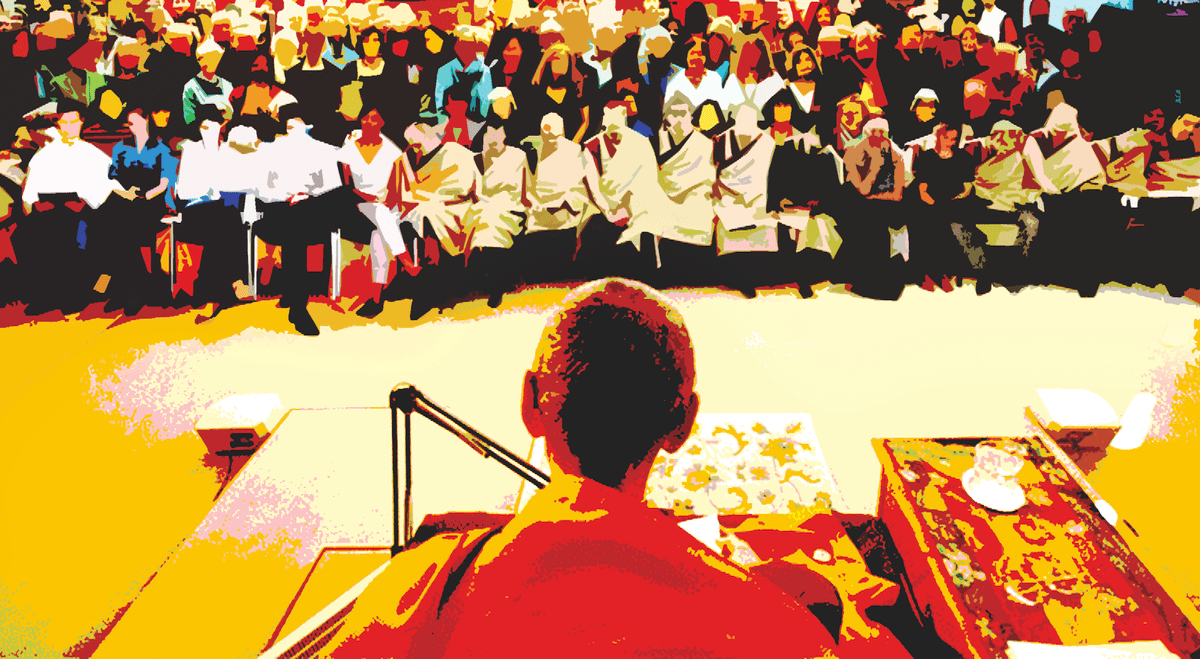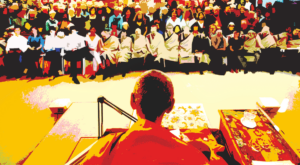As a Buddhist teacher, I am often asked questions about meditation and profound Buddhist principles, like interdependence and emptiness. I am happy to share what I know on these topics. But I have noticed that people rarely ask me about ethics and how to live a virtuous life.
It is true that meditation is important in the Buddhist tradition. There’s no question about that. The same can be said about studying Buddhist ideas and philosophies. But in many ways, ethics and virtue are the foundation of the Buddhist path.
The one time people do ask me about ethics is when scandals or controversies happen in Buddhist communities.
The Buddha himself lived a life of kindness, humility, and compassion. He fully embodied the teachings he gave, and the sangha that grew around him followed his example. There were many times when the students got off track and acted inappropriately—sometimes hilariously so—but these incidents were used as opportunities to clarify important values and to show the community how to live a life of virtue. From the early days of Buddhism, ethical conduct was as central to the path as meditation, study, and contemplation.
These days, the one time people do ask me about ethics is when scandals or controversies happen in Buddhist communities. Despite the clear importance of nonviolence and compassion in the Buddhist tradition, many students are not sure how to deal with these situations. I can see why they get confused. There are many different Buddhist lineages and schools, and it is hard to keep track of all their different teachings, practices, and ethical frameworks.
This is especially true in the Tibetan tradition, where we have three different approaches—which we call yanas or “vehicles”—that are woven together into one path of Buddhist practice. These are the Foundational vehicle of individual liberation, the Mahayana vehicle of great compassion, and the Vajrayana vehicle of indestructible wakefulness. This combination is one of the unique and beautiful aspects of Tibetan Buddhism, but it doesn’t always make things simple.
Ethics in Tibetan Buddhism
In Tibetan Buddhism we practice the three yanas together, and that includes the practice of ethics. Let me clarify.
The most basic ethical principle in the yana of individual liberation is nonviolence, the commitment to avoid harming others at all costs.
Vajrayana practice is rooted in the ideals of nonviolence and great compassion. There is no Vajrayana without them.
When we add in the Mahayana, we do not forget about nonviolence, but take it one step further with the practice of bodhichitta. This is the commitment to help all beings become fully enlightened.
Finally, Vajrayana brings in the notion of pure perception. In practicing the Vajrayana, we remain firmly grounded in nonviolence and the altruistic motivation of bodhichitta, but take the fruitional view. We treat everyone and everything as the embodiment of awakening. We commit ourselves to seeing ourselves, others, and the world around us as fundamentally pure, complete, and perfect.
This ideal of pure perception is embodied in the principle of samaya, the formal commitments that a Vajrayana practitioner adheres to. There many details about samaya, but simply put the essence of samaya is to practice pure perception to the best of one’s ability.
Many people misunderstand samaya and think it refers only to seeing the teacher as a buddha, a fully awakened being. That is part of samaya, but it misses the key point. Samaya is about seeing everyone and everything through the lens of pure perception. The sole purpose of viewing the teacher as a buddha is so we can see these same awakened qualities in ourselves, in others, and in the world around us. It is a tool that helps us to gain confidence in the purity of our true nature.
Vajrayana practice is rooted in the ideals of nonviolence and great compassion. There is no Vajrayana without them. So how do we use these principles to guide us on important issues like finding an authentic teacher and working with the inevitable challenges that arise in the life of a community?
The Point of Practice
The first point I’d like to make is probably an obvious one. Our practice should bring out the best in us as human beings. It should call forth our inner wisdom, our basic sanity, and the moral compass that we all have (whether we pay attention to it or not).
The most basic way to measure our practice, therefore, is the degree to which we are moving closer to the simple ideals of kindness, humility, honesty, and wisdom. If—as individuals or as communities—we find ourselves moving in the other direction, something is off track. None of us will act perfectly in every situation, but over time there should be a clear movement toward these basic and universal human values.
This is especially true of spiritual teachers. Buddhist teachers are role models and guides for the communities they lead, and they represent the Buddhist tradition to the non-Buddhist world. If, as students of the Buddha’s teachings, we strive to be kind, humble, and devoted to practice, then it only makes sense that our guides should embody these qualities. They should inspire us with their kindness and devotion. They should instill trust by the care and concern they show for others. Of course, we should not expect perfection, but it should go without saying that people who are guiding others should practice what they preach.
Finding a Genuine Teacher
When it comes to finding a genuine teacher, there are four things that are especially important.
The first is that the teacher should be part of an authentic lineage. Genuine teachers do not promote themselves; they promote their lineage. If a teacher brags about their qualities and realization and makes a show of their practice, that is probably an indication that something is not quite right. But if a teacher has studied and practiced under the guidance of other respected teachers, and honors their lineage by upholding its values and traditions, that is a good sign. Lineage alone does not make a teacher genuine, but it is important.
A genuine teacher should uphold their vows and precepts.
The second quality to look for is commitment to study and practice. This one is pretty obvious. You would not take piano lessons from someone who’s not a good player themselves, would you? Of course not. The same is true here. If you are trusting someone with your spiritual well-being, you should be sure that this person knows the path first-hand. In order to do this, they should have a clear commitment to their own practice and training.
The third essential quality is compassion. As students, we need to feel confident that our teacher is on our side—that they have our best interests at heart and deeply care about us and our progress on the path.
Trust is critical here. A genuine teacher is trustworthy and puts the needs of the student first. The sign of a teacher who has this quality is that students feel safe and protected in their care. They know that no matter what is going on in their life, their teacher will always be there to guide and support them.
The fourth and final quality is the one that relates the most directly to ethics. A genuine teacher should uphold their vows and precepts. In the Tibetan tradition, that means they maintain whatever monastic or lay vows they have taken, adhere to the bodhisattva vows of the Mahayana, and keep the samaya vows of the Vajrayana.

This is no small feat, but it is very important. There are lots of details included in this one, and as students we may not know exactly what vows a person holds. But we can ask around and check to see if there are any questions about a teacher’s behavior or conduct. That is a good place to start.
In this day and age, it is not easy to find a perfect teacher. The time of the Buddha, when people seemed to get enlightened just by showing up, is long gone. We may not find a teacher who perfectly embodies all four of these qualities, but they should have all of them to some degree. If a teacher is completely lacking one or more of these qualities, it is probably best to move on.
Leaving a Teacher
These four qualities are a good general guideline to follow when looking for a teacher. But even when we do our best to research a teacher first, often we only really get to know the teacher after becoming their student. In the modern world, most of us do not have a monastery or Buddhist expert down the street. We do not necessarily know all the details about a teacher, or even have someone we can ask. So what do we do when we discover that a teacher is not quite what we hoped?
If someone is being harmed, the safety of the victim comes first. This is not a Buddhist principle. This is a basic human value and should never be violated.
Many students of Tibetan Buddhism mistakenly think that they cannot, or should not, leave a teacher once they’ve made a commitment to them. This is not the case. The whole point of the teacher–student relationship is that it should benefit the student. It is not for the teacher’s gain or profit. If you have tried your best and have found that it is not a good fit, you can look for another teacher. This is not a problem or personal failing. It is good judgment.
The best way to leave is to do so without bad-mouthing the teacher or creating difficulties for those who may be benefiting from the teacher and the community. Leave on good terms, or at the very least, do not leave on bad terms. Simply move on with humility and do not feel bad about the fact that it did not work out.
The one caveat I would add here is that it is important to be honest with yourself. Leaving a teacher or community that does not seem to be a good fit is understandable, but if you find every teacher unworthy of your time, then you may want to look deeper into your own patterns to see what is going on. It may be difficult to make any progress on the path if you are looking for perfection.
Serious Ethical Violations
However, it is another matter altogether when a teacher is committing serious ethical violations. Leaving a teacher on good terms makes sense when the issue is just a matter of fit between teacher and student. When the issue is people being hurt or laws being broken, the situation is different.
In that case, the violation of ethical norms needs to be addressed. If physical or sexual abuse has occurred, or there is financial impropriety or other breaches of ethics, it is in the best interest of the students, the community, and ultimately the teacher, to address the issues. Above all, if someone is being harmed, the safety of the victim comes first. This is not a Buddhist principle. This is a basic human value and should never be violated.
Physical, sexual, and psychological abuse are not teaching tools.
The appropriate response depends on the situation. In some cases, if a teacher has acted inappropriately or harmfully but acknowledges the wrongdoing and commits to avoiding it in the future, then dealing with the matter internally may be adequate. But if there is a long-standing pattern of ethical violations, or if the abuse is extreme, or if the teacher is unwilling to take responsibility, it is appropriate to bring the behavior out into the open.
In these circumstances, it is not a breach of samaya to bring painful information to light. Naming destructive behaviors is a necessary step to protect those who are being harmed or who are in danger of being harmed in the future, and to safeguard the health of the community.
Crazy Wisdom
The Vajrayana tradition has a history of eccentric yogis and yoginis and teachers who used extreme methods to guide their students. The story of Marpa asking Milarepa to build and then dismantle a series of stone towers is perhaps the most famous example of this. This tradition of “crazy wisdom” can be authentic, but unfortunately it is often invoked as a rationalization for unethical behavior that has nothing to do with wisdom or compassion.
The most important thing to know about these unusual teaching styles is that they are meant to benefit the student. If they are not rooted in compassion and wisdom, they are not genuine. Actions that are rooted in compassion and wisdom—even when they appear odd, eccentric, or even wrathful—do not instill fear or anxiety. They bring about a flowering of compassion and wisdom in the student.
We must distinguish teachers who are eccentric or provocative—but ultimately compassionate and skillful—from those who are actually harming students and causing trauma.
In other words, the results of genuine “crazy wisdom” are always positive and visible. When a teacher uses an extreme approach that is rooted in compassion, the result is spiritual growth, not trauma. Trauma is a sure sign that the “crazy wisdom” behavior was missing the wisdom to see what would truly benefit the student, the compassion that puts the student’s interest first, or both.
It is also worth noting that these extreme teaching styles we see in Vajrayana history took place in the context of a very mature spiritual bond between teacher and student. They were not all that common. Marpa didn’t make all of his students build stone towers. In fact, he treated his other students very differently from how he treated Milarepa. But he saw Milarepa’s potential and the approach that would benefit him most. The rest is history. Milarepa became enlightened and one of Tibet’s greatest adepts.
Not only are these extreme teaching methods used only with very mature students and in the context of a relationship of stable trust and devotion, they are also a last resort. There are said to be four kinds of enlightened activity: peaceful, magnetizing, enriching, and wrathful. Wrathful activity is only used for those who are not receptive to more subtle approaches. So again, this style is not a norm, but something that is only employed in certain circumstances.
Thus we must distinguish teachers who are eccentric or provocative—but ultimately compassionate and skillful—from those who are actually harming students and causing trauma. These are two very different things, and it is important that we do not lump them together. There are plenty of teachers who push and provoke students to help them learn about their minds, but that is not abuse. Physical, sexual, and psychological abuse are not teaching tools.
Vajrayana in the Modern World
Now that the world is so interconnected, ethics are more important than ever. In a sense, we Buddhist practitioners are all representing the Buddha’s teachings to the world. Anyone can learn about this teacher or that sangha with a few mouse clicks and a quick Google search. This is a good thing, because it makes the entire tradition more transparent. Ethical behavior—and ethical violations—are more visible than they were in previous times.
It should go without saying that when schools, businesses, and other public institutions are expected to adhere to a code of conduct and the laws of the land, then spiritual organizations should be role models of ethical behavior. And teachers even more so. Throughout history, one of the most important roles of Buddhist teachers and the Buddhist sangha was exactly this. They modeled ethical behavior to the communities that they served.
Vajrayana Buddhism is thought of as a precious treasure by Tibetans. It is our spiritual heritage and our gift to the world. Now that the teachings and practices of this tradition are spreading across the globe, it is important that we understand the tradition and how to work with its powerful teachings.
As I’ve said, the core of the Vajrayana tradition is that we strive to embody pure perception. We view our thoughts and emotions—even the difficult ones—as manifestations of timeless awareness. We see every person as a buddha, and we treat them as such. We view the world that we live in as a pure realm, enlightened just as it is.
This tradition of treating everything and everyone as though we are meeting the Buddha face-to-face is our main practice in the Vajrayana. It is the life blood of our tradition and the very highest ethical standard we could aspire to. In this day and age, with confusion and conflict all around us, the world needs this more than ever.
This article is available in Spanish in our section El Camino del Buda.
Este artículo está disponible en Español en nuestra sección El Camino del Buda.


